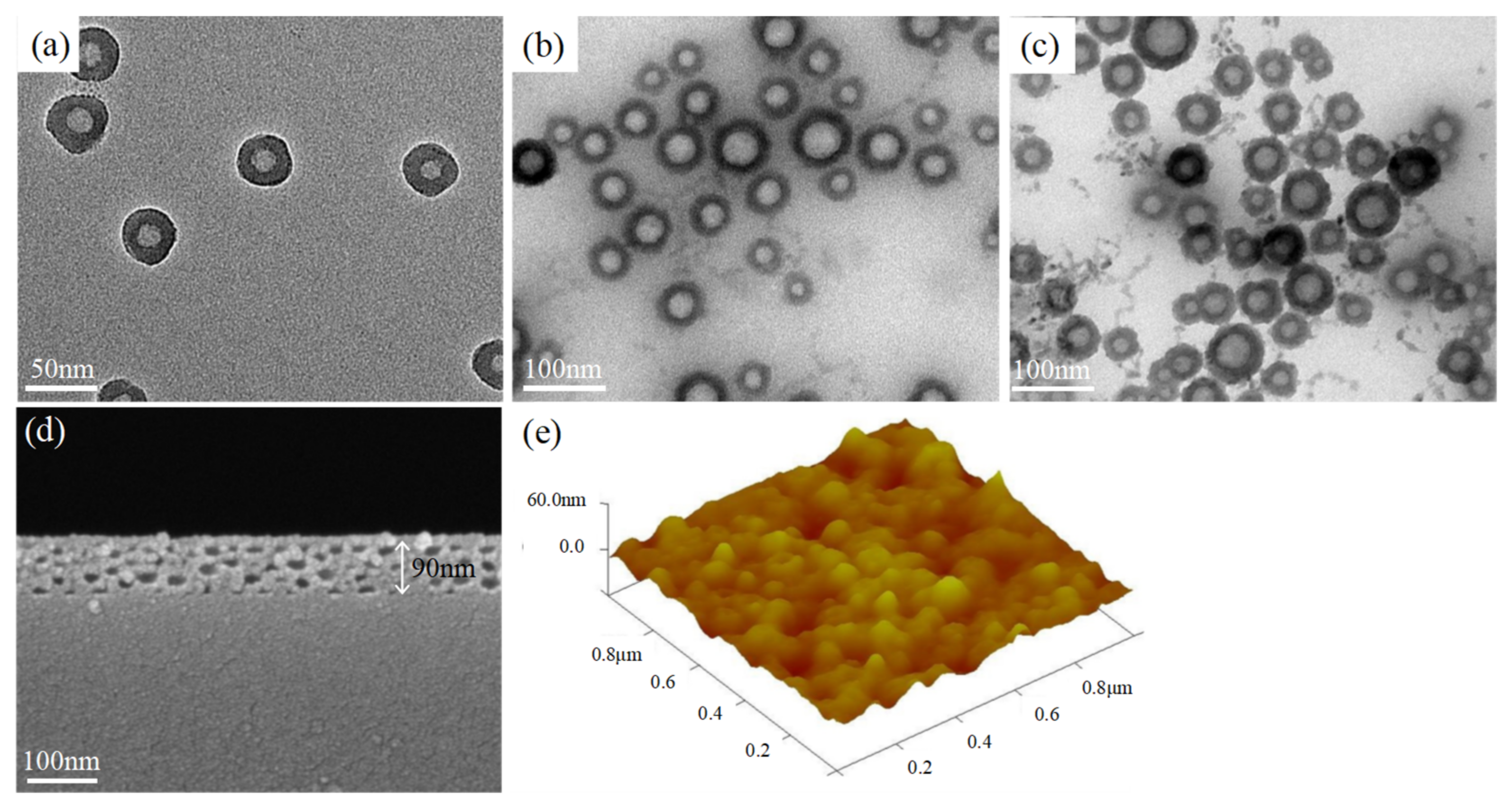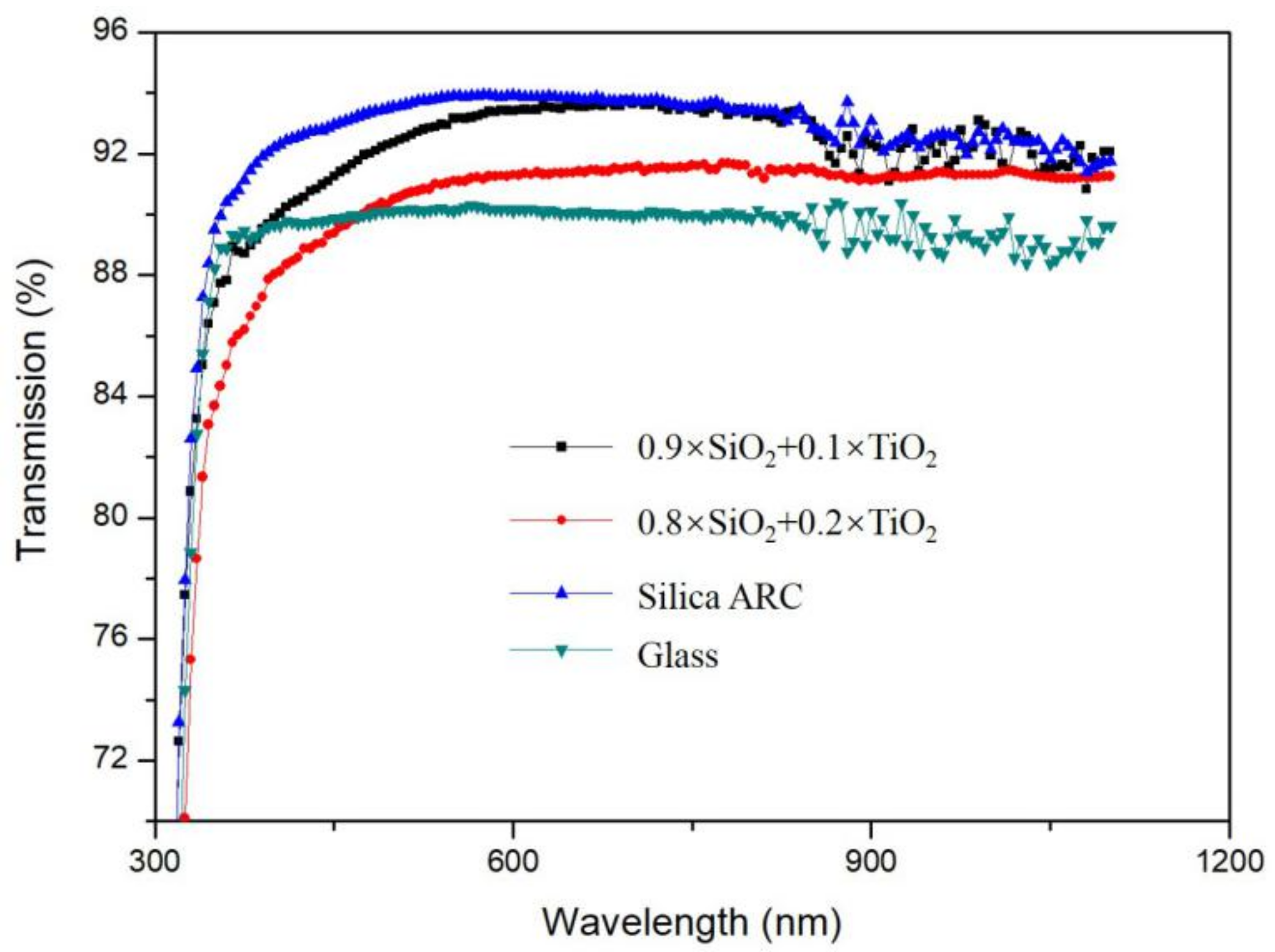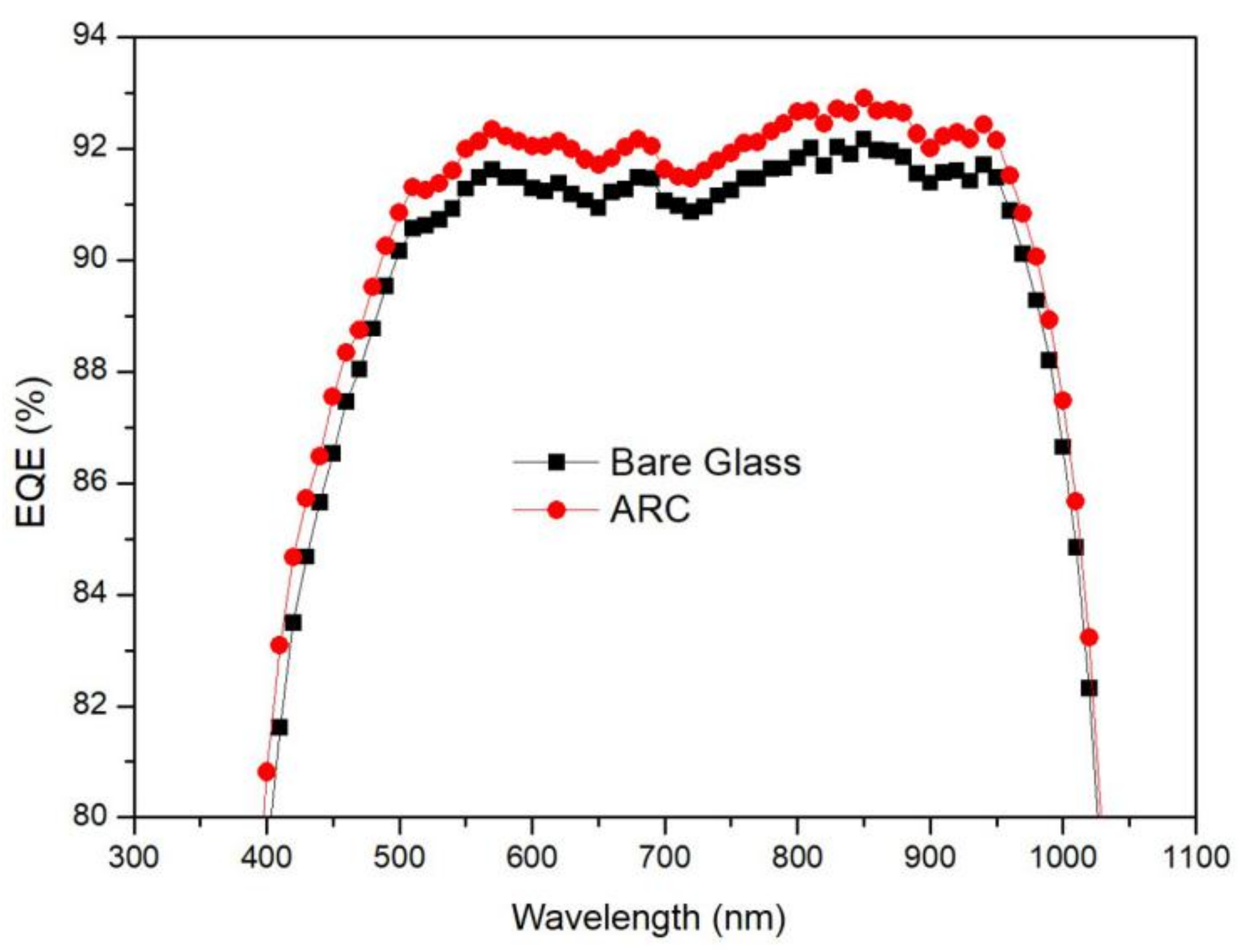Closed-Surface Multifunctional Antireflective Coating Made from SiO2 with TiO2 Nanocomposites
Abstract
:1. Introduction
2. Materials and Methods
2.1. Materials
2.2. Preparation of Solutions
2.3. Fabrication of Closed-Surface Self-Cleaning ARCs
2.4. Characterization of Microstructure and Morphology
2.5. Evaluation of Photocatalytic Properties
2.6. Optical Property Measurements
2.7. Flashing Test and External Quantum Efficiency (EQE) Measurement of a PV Module
2.8. Long-Term Reliability Evaluation
3. Results and Discussion
3.1. Structure and Morphology of SiO2-TiO2 Closed-Surface ARC
3.2. Photocatalytic Properties of SiO2-TiO2 Closed-Surface ARCs
3.3. Optics of SiO2-TiO2 Closed-Surface ARCs
3.4. Photovoltaic Device Performance of SiO2-TiO2 Closed-Surface ARC
3.5. Mechanical Properties of SiO2-TiO2 Closed-Surface ARC
3.6. Long-Term Reliability of SiO2-TiO2 Closed-Surface ARC
4. Conclusions
Author Contributions
Funding
Institutional Review Board Statement
Informed Consent Statement
Data Availability Statement
Acknowledgments
Conflicts of Interest
References
- Schallenberg, U.B. Antireflection design concepts with equivalent layer. Appl. Opt. 2006, 45, 1507–1514. [Google Scholar] [CrossRef]
- Mehmood, U.; Al-Sulaiman, F.A.; Yilbas, B.S.; Salhi, B.; Ahmed, S.H.A.; Hossain, M.K. Superhydrophobic surfaces with antireflection properties for solar applications: A critical review. Sol. Energy Mater. Sol. Cells 2016, 157, 604–623. [Google Scholar] [CrossRef]
- Yang, Z.Y.; Zu, D.Q.; Lu, D.S. The relationship between porous ratio and refractive index in nanoporous film. Acta Opt. Sin. 2003, 23, 1366–1369. [Google Scholar] [CrossRef]
- Chen, J.; Zhang, L.; Zeng, Z.; Wang, G.; Liu, G.; Zhao, W.; Xue, Q. Facile fabrication of antifogging, antireflective, and self-cleaning transparent silica thin coatings. Colloids Surf. A 2016, 509, 149–157. [Google Scholar] [CrossRef]
- Jilavi, M.H.; Mousavi, S.H.; Müller, T.S.; Oliveira, P.W. Dual functional porous anti-reflective coatings with a photocatalytic effect based on a single layer system. Appl. Surf. Sci. 2018, 439, 323–328. [Google Scholar] [CrossRef]
- Astrova, E.V.; Tolmachev, V.A. Effective refractive index and composition of oxidized porous silicon films. Mater. Sci. Eng. B 2000, 69, 142–148. [Google Scholar] [CrossRef]
- Hedayati, M.K.; Elbahri, M. Antireflective coatings: Conventional stacking layers and ultrathin plasmonic metasurfaces, a mini-review. Materials 2016, 9, 497. [Google Scholar] [CrossRef] [Green Version]
- Lim, K.P.; Wang, Q. Dual-layer ultrathin film optics: II. Experimental studies and designs. J. Opt. 2015, 17, 035614. [Google Scholar] [CrossRef]
- Park, K.C.; Choi, H.J.; Chang, C.-H.; Cohen, R.W.; McKinley, G.H.; Barbastathis, G. Nanotextured silica surfaces with robust super hydrophobicity and omnidirectional broadband super transmissivity. ACS Nano 2012, 6, 3789–3799. [Google Scholar] [CrossRef]
- Chen, C.H.; Li, S.Y.; Chiang, A.S.T.; Wu, A.T.; Sun, Y.S. Scratch-resistant zeolite anti-reflective coating on glass for solar applications. Sol. Energy Mater. Sol. Cells 2011, 95, 1694–1700. [Google Scholar] [CrossRef]
- Zhang, X.; Lan, P.; Lu, Y.; Li, J.; Xu, H.; Zhang, J.; Lee, Y.P.; Rhee, J.Y.; Choy, K.-L.; Song, W.W. Multifunctional antireflection coatings based on novel hollow silica-silica nanocomposites. ACS Appl. Mater. Interfaces 2014, 6, 1415–1423. [Google Scholar] [CrossRef] [PubMed]
- Du, Y.; Luna, L.E.; Tan, W.S.; Rubner, M.F.; Cohen, R.E. Hollow silica nanoparticles in UV− visible antireflection coatings for poly (methyl methacrylate) substrates. ACS Nano 2010, 4, 4308–4316. [Google Scholar] [CrossRef] [PubMed]
- Guo, Z.Q.; Liu, Y.; Tang, M.Y.; Wang, J.H.; Su, X.P. Super-durable closed surface antireflection thin film by silica nanocomposites. Sol. Energy Mater. Sol. Cells 2017, 170, 143–148. [Google Scholar] [CrossRef]
- Čizmić, M.; Ljubas, D.; Rožman, M.; Ašperger, D.; Ćurković, L.; Babić, S. Photocatalytic Degradation of Azithromycin by Nanostructured TiO2 Film: Kinetics, Degradation Products, and Toxicity. Materials 2019, 12, 873. [Google Scholar] [CrossRef] [Green Version]
- Chiodi, M.; Cheney, C.P.; Vilmercati, P.; Vilmercati, P.; Cavaliere, E.; Mannella, N.; Weitering, H.H.; Gavioli, L. Enhanced dopant solubility and visible-light absorption in Cr-N codoped TiO2 nanoclusters. J. Phys. Chem. C 2012, 116, 311–318. [Google Scholar] [CrossRef]
- Huang, J.D.; Wen, S.H.; Liu, J.Y.; He, G.Z. Band gap narrowing of TiO2 by compensated codoping for enhanced photocatalytic activity. J. Nat. Gas Chem. 2012, 21, 302–307. [Google Scholar] [CrossRef]
- Kermadi, S.; Agoudjil, N.; Sali, S.; Zougar, L.; Boumaour, M.; Broch, L.; Naciri, A.E.; Placido, F. Microstructure and optical dispersion characterization of nanocomposite sol-gel TiO2-SiO2 thin films with different compositions. Spectrochim. Acta Part A 2015, 145, 145–154. [Google Scholar] [CrossRef]
- Tao, C.; Zhang, L. Fabrication of multifunctional closed-surface SiO2-TiO2 antireflective thin films. Colloids Surf. A 2020, 585, 124045. [Google Scholar] [CrossRef]
- Yao, L.; He, J.H.; Geng, Z.; Ren, T.T. Fabrication of mechanically robust, self-cleaning and optically high-performance hybrid thin films by SiO2 & TiO2 double-shelled hollow nanospheres. Nanoscale 2015, 7, 13125–13134. [Google Scholar] [CrossRef]
- Liu, J.; Wang, K.; Zheng, W.; Huang, W.; Li, C.-H.; You, X.-Z. Improving spectral response of monocrystalline silicon photovoltaic modules using high efficient luminescent down-shifting Eu3+ complexes. Prog. Photovolt. 2013, 21, 668–675. [Google Scholar] [CrossRef]
- Moghal, J.; Kobler, J.; Sauer, J.; Best, J.; Gardener, M.; Watt, A.A.R.; Wakefield, G. High-performance, single-layer antireflective optical coatings comprising mesoporous silica nanoparticles. ACS Appl. Mater. Interfaces 2012, 4, 854–859. [Google Scholar] [CrossRef]
- Alam, K.; Ali, S.; Saher, S.; Humayun, M. Silica nano-particulate coating having self-cleaning and antireflective properties for PV modules. In Proceedings of the 2018 IEEE 21st International Multi-Topic Conference (INMIC), Karachi, Pakistan, 1–2 November 2018; pp. 1–5. [Google Scholar] [CrossRef]
- Tao, C.Y.; Yan, H.W.; Yuan, X.D.; Yin, Q.; Zhu, J.Y.; Ni, W.; Yan, L.H.; Zhang, L. Sol-gel preparation of moisture-resistant antireflective coatings from novel hollow silica nanoparticles. J. Sol-Gel Sci. Technol. 2016, 80, 538–547. [Google Scholar] [CrossRef]
- Cai, S.; Zhang, Y.L.; Zhang, H.L.; Yan, H.W.; Lv, H.B.; Jiang, B. Sol-gel preparation of hydrophobic silica antireflective coatings with low refractive index by base/acid two-step catalysis. ACS Appl. Mater. Interfaces 2014, 6, 11470–11475. [Google Scholar] [CrossRef]
- Zhang, X.X.; Ye, H.P.; Xiao, B.; Yan, L.H.; Lv, H.B.; Jiang, B. Sol-gel preparation of PDMS/Silica hybrid antireflective coatings with controlled thickness and durable antireflective performance. J. Phys. Chem. C 2010, 114, 19979–19983. [Google Scholar] [CrossRef]
- Dey, T.; Naughton, D. Cleaning and anti-reflective (AR) hydrophobic coating of glass surface: A review from materials science perspective. J. Sol-Gel Sci. Technol. 2016, 77, 1–27. [Google Scholar] [CrossRef]
- Li, D.; Wan, D.; Zhu, X.; Wang, Y.; Han, Z.; Han, S.; Han, Y.S.; Huang, F. Broadband antireflection TiO2-SiO2 stack coatings with refractive-index-grade structure and their applications to Cu(In,Ga)Se2 solar cells. Sol. Energy Mater. Sol. Cells 2014, 130, 505–512. [Google Scholar] [CrossRef]
- Liu, Z.; Zhang, X.; Murakami, T.; Fujishima, A. Sol-gel SiO2/TiO2 bilayer films with self-cleaning and antireflection properties. Sol. Energy Mater. Sol. Cells 2008, 92, 1434–1438. [Google Scholar] [CrossRef]
- Yoldas, B.E. Investigations of porous oxides as an antireflective coating for glass surfaces. Appl. Opt. 1980, 19, 1425. [Google Scholar] [CrossRef]
- Sahoo, G.S.; Mishra, G.P. Effect of wideband gap tunnel diode and thickness of the window layer on the performance of a dual junction solar cell. Procedia Technol. 2016, 25, 684–691. [Google Scholar] [CrossRef] [Green Version]
- Ballif, C.; Dicker, J.; Borchert, D.; Hofmann, T. Solar glass with industrial porous SiO2 antireflection coating: Measurements of photovoltaic module properties improvement and modelling of yearly energy yield gain. Sol. Energy Mater. Sol. Cells 2004, 82, 331–344. [Google Scholar] [CrossRef]
- Noh, Y.A.; Kim, K.C. Transparent hydrophobic anti-reflection coating with SiO2/TiO2 thin layers. J. Korean Med. Sci. 2017, 18, 1–6. [Google Scholar] [CrossRef]
- Wang, J.D.; Ge, J.J.; Hou, H.G.; Wang, M.S.; Liu, G.W.; Qiao, G.J.; Wang, Y.S. Design and sol-gel preparation of SiO2/TiO2 and SiO2/SnO2/SiO2-SnO2 multilayer antireflective coatings. Appl. Surf. Sci. 2017, 422, 970–974. [Google Scholar] [CrossRef]
- International Electrotechnical Commission. Terrestrial Photovoltaic (PV) Modules—Design Qualification and Type Approval—Part 2: Test Procedures; International Electrotechnical Commission (IEC): Geneva, Switzerland, 2016. [Google Scholar]
- Aghaei, R.; Eshaghi, A.; Aghaei, A.A. Durable transparent super-hydrophilic hollow SiO2-SiO2 nanocomposite thin film. Mater. Chem. Phys. 2018, 219, 347–360. [Google Scholar] [CrossRef]
- Womack, G.; Kaminski, P.M.; Abbas, A.; Isbilir, K.; Gottschalg, R.; Walls, J.M. Performance and durability of broadband antireflection coatings for thin film CdTe solar cells. J. Vac. Sci. Technol. A 2017, 35, 021201. [Google Scholar] [CrossRef] [Green Version]





Publisher’s Note: MDPI stays neutral with regard to jurisdictional claims in published maps and institutional affiliations. |
© 2021 by the authors. Licensee MDPI, Basel, Switzerland. This article is an open access article distributed under the terms and conditions of the Creative Commons Attribution (CC BY) license (http://creativecommons.org/licenses/by/4.0/).
Share and Cite
Guo, Z.; Zhu, Z.; Liu, Y.; Wu, C.; Tu, H.; Wang, J.; Su, X. Closed-Surface Multifunctional Antireflective Coating Made from SiO2 with TiO2 Nanocomposites. Materials 2021, 14, 1367. https://doi.org/10.3390/ma14061367
Guo Z, Zhu Z, Liu Y, Wu C, Tu H, Wang J, Su X. Closed-Surface Multifunctional Antireflective Coating Made from SiO2 with TiO2 Nanocomposites. Materials. 2021; 14(6):1367. https://doi.org/10.3390/ma14061367
Chicago/Turabian StyleGuo, Zhiqiu, Ze Zhu, Ya Liu, Changjun Wu, Hao Tu, Jianhua Wang, and Xuping Su. 2021. "Closed-Surface Multifunctional Antireflective Coating Made from SiO2 with TiO2 Nanocomposites" Materials 14, no. 6: 1367. https://doi.org/10.3390/ma14061367







